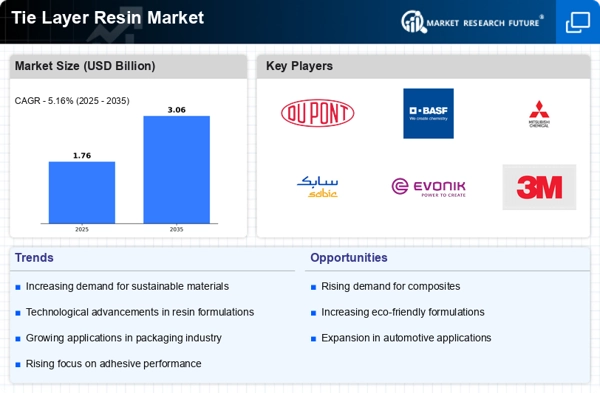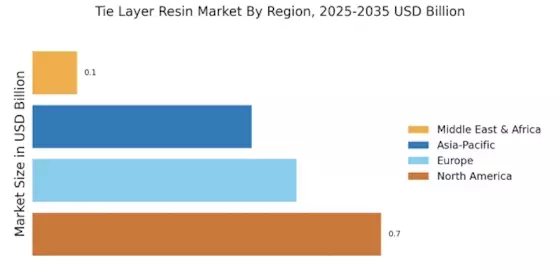Growth in the Automotive Sector
The automotive sector's expansion is a notable driver for the Tie Layer Resin Market. As vehicles become more complex and manufacturers strive for lightweight materials to improve fuel efficiency, the demand for advanced composite materials is increasing. Tie layer resins are essential in bonding dissimilar materials, such as plastics and metals, which are commonly used in automotive applications. The automotive industry is projected to grow at a rate of 4% annually, with a significant focus on enhancing vehicle performance and safety. This growth is likely to boost the consumption of tie layer resins, as they are integral to the production of lightweight and durable automotive components, thereby fostering growth in the Tie Layer Resin Market.
Advancements in Adhesive Technologies
Technological advancements in adhesive formulations are significantly influencing the Tie Layer Resin Market. Innovations in resin chemistry have led to the development of adhesives that offer superior bonding capabilities, thermal stability, and chemical resistance. These advancements are particularly relevant in industries such as automotive and electronics, where the performance of materials is critical. The market for adhesives is expected to reach USD 70 billion by 2026, with tie layer resins playing a crucial role in enhancing the performance of these adhesives. As manufacturers seek to improve product durability and functionality, the demand for high-performance tie layer resins is likely to increase, thereby driving growth in the Tie Layer Resin Market.
Rising Demand for Multi-Layer Packaging
The increasing demand for multi-layer packaging solutions is a primary driver for the Tie Layer Resin Market. As consumer preferences shift towards products that offer enhanced protection and longer shelf life, manufacturers are increasingly adopting multi-layer packaging technologies. This trend is particularly evident in the food and beverage sector, where the need for barrier properties against moisture and oxygen is paramount. According to recent data, the multi-layer packaging market is projected to grow at a compound annual growth rate of approximately 5.5% over the next few years. This growth directly correlates with the rising consumption of tie layer resins, which serve as essential components in these packaging solutions, thereby propelling the Tie Layer Resin Market forward.
Increased Focus on Product Customization
The trend towards product customization is emerging as a key driver for the Tie Layer Resin Market. As consumers demand more personalized products, manufacturers are compelled to innovate and adapt their offerings. This trend is particularly evident in sectors such as consumer electronics and packaging, where tailored solutions are becoming increasingly popular. The customization of products often requires specialized materials, including tie layer resins that can provide unique properties tailored to specific applications. The market for customized products is expected to grow significantly, with projections indicating a rise of over 6% annually. This shift towards customization is likely to enhance the demand for tie layer resins, thereby positively influencing the Tie Layer Resin Market.
Regulatory Support for Sustainable Materials
Regulatory frameworks promoting the use of sustainable materials are emerging as a significant driver for the Tie Layer Resin Market. Governments and regulatory bodies are increasingly mandating the use of eco-friendly materials in packaging and construction applications. This shift is encouraging manufacturers to adopt tie layer resins that are derived from renewable resources or are recyclable. For instance, the European Union's Green Deal aims to make Europe climate-neutral by 2050, which includes initiatives to reduce plastic waste. As a result, the demand for sustainable tie layer resins is expected to rise, aligning with the broader trend towards sustainability in various industries, thus positively impacting the Tie Layer Resin Market.


















Leave a Comment